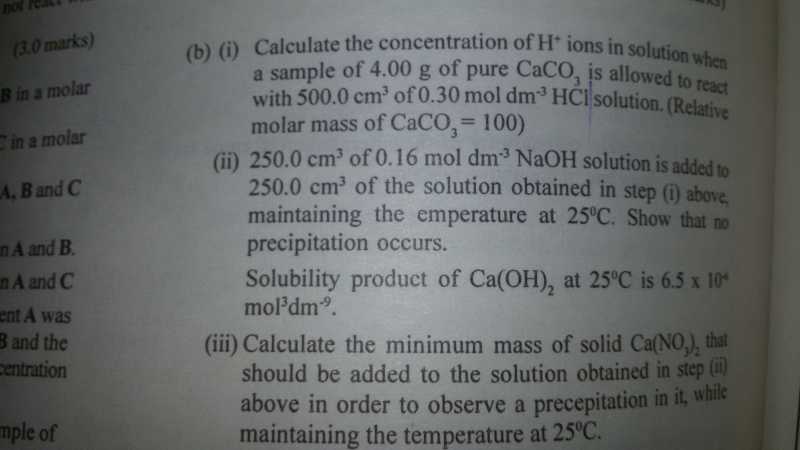Question #15440
2 Answers
!! VERY LONG ANSWER !!

Part (i)
Start with the balanced chemical equation for the reaction that takes place between calcium carbonate and hydrochloric acid
Even before doing any calculations, you can predict that not all the
You have a
So, you're dealing with
and
The initial prediction is correct, calcium carbonate will act as a limiting reagent, which implies that the reaction will only consume
The number of moles of hydrochloric acid left in solution will be
Since
This means that you'll get
The molarity of the
Part (ii)
Now you add the sodium hydroxide solution. The strong base will neutralize the remaining moles of
The number of moles of sodium hydroxide you add is
However, keep in mind that you add this many moles of sodium hydroxide to 250.0 mL of the initial solution, so the number of moles of
This means that all of the acid will be consumed by the neutralization reaction, and you'll only be left with
Now a second reaction takes place. The calcium chloride will react with the sodium hydroxide to produce calcium hydroxide,
The first reaction produce 0.0400 moles of
The total volume of the solution will be
The [molarities] of the compounds will be
The net ionic equation for the above reaction will be
By definition, the solubility product constant will be
Since this value is smaller than the
Part (iii)
Now you have to determine how much calcium nitrate,
To do that, use the concentration of the hydroxide ions to determine what the minimum concentration of calcium cations should be.
This is equivalent to having
You already have 0.0200 moles, so you need to add
Use the molar mass of the calcium nitrate to determine how much you'd need
And that's about it.
I will give you a detailed and stepped route to solve the problem instead of the completely worked out solution. Please ask us if you don't understand how to do any single instruction.
-
Write and balance the reaction equation occurring from reactants
CaCO_3 + HCl -> yielding carbon dioxide, calcium dichloride and water as products. -
Calculate the amount of each reactant in moles and determine which is the limiting one (consider the stoichiometric coefficient ratio). From step (ii) is evident that solid calcium carbonate will be completely dissolved and an excess of hydrochloric acid will remain. Calculate this excess amount in moles.
-
Consider that half of these moles of HCl (250 mL by 500 mL) will be mixed with a bigger amount of NaOH moles (that you must calculate from 250 mL of 0,16 M NaOH as given in (ii)). From the 1:1 neutralization reaction between limited HCl and exceeding NaOH you'll remain with an amount of hydroxide ions given as the difference between NaOH moles and HCl moles. Convert these
OH^- moles in[OH^-] molar concentration, remembering that the whole solution has now a volume of 250 + 250 mL. -
Given that calcium was completely dissolved in step (i) and that you have halved out its moles by taking half volume in step (ii), you may calculate
[Ca^"2+"] concentration in the 500 mL solution in step (ii). Then, substitute calcium and hydroxide molar concentration to demonstrate that actual[Ca^"2+"]*[OH^-]^2 < 6.5*10^"-6" (i.e. no precipitation can occur). -
Solve the equation
[Ca^"2+"]*[OH^-]^2 = 6.5*10^"-6" for[Ca^"2+"] (given the[OH^-] concentration calculated in step 3). From this concentration subtract the[Ca^"2+"] concentration actually present in the solution that you have calculated in step 4. What you get now is the extra concentration of calcium ions that you have to put into the solution as solid calcium nitrate to initiate the precipitation of calcium hydroxide. -
Convert this extra
[Ca^"2+"] concentration in moles of calcium = moles of calcium nitrate in half a dm³ or liter, and then in grams of calcium nitrate to be added in the 500 cm³ or 0,5 dm³, provided the molar mass ofCa(NO_3)_2 is 164 grams per mole. Then you will have worked out part (iii) too.


